Recent Progress in Transition Metal Dichalcogenides for Electrochemical Biomolecular Detection
Abstract
:1. Introduction
2. Structure and Properties
3. Synthesis
3.1. Top–Down Synthesis Methods
3.2. Bottom–Up Synthesis Methods
4. Electrochemical Biosensor and Application of TMDs for Detection of Biomolecules
4.1. Small Molecules
4.2. Complex Molecules
5. Future Perspectives
6. Conclusions
Author Contributions
Funding
Data Availability Statement
Conflicts of Interest
References
- Mia, A.K.; Meyyappan, M.; Giri, P.K. Two-Dimensional Transition Metal Dichalcogenide Based Biosensors: From Fundamentals to Healthcare Applications. Biosensors 2023, 13, 169. [Google Scholar] [CrossRef] [PubMed]
- Hu, Y.; Huang, Y.; Tan, C.; Zhang, X.; Lu, Q.; Sindoro, M.; Huang, X.; Huang, W.; Wang, L.; Zhang, H. Two-Dimensional Transition Metal Dichalcogenide Nanomaterials for Biosensing Applications. Mater. Chem. Front. 2017, 1, 24–36. [Google Scholar] [CrossRef]
- Tajik, S.; Dourandish, Z.; Garkani Nejad, F.; Beitollahi, H.; Jahani, P.M.; Di Bartolomeo, A. Transition Metal Dichalcogenides: Synthesis and Use in the Development of Electrochemical Sensors and Biosensors. Biosens. Bioelectron. 2022, 216, 114674. [Google Scholar] [CrossRef] [PubMed]
- Walsh, L.A.; Addou, R.; Wallace, R.M.; Hinkle, C.L. Molecular Beam Epitaxy of Transition Metal Dichalcogenides. In Molecular Beam Epitaxy; Elsevier: Amsterdam, The Netherlands, 2018; pp. 515–531. [Google Scholar] [CrossRef]
- Manzeli, S.; Ovchinnikov, D.; Pasquier, D.; Yazyev, O.V.; Kis, A. 2D Transition Metal Dichalcogenides. Nat. Rev. Mater. 2017, 2, 17033. [Google Scholar] [CrossRef]
- Rojas, D.; Della Pelle, F.; Del Carlo, M.; Compagnone, D.; Escarpa, A. Group VI Transition Metal Dichalcogenides as Antifouling Transducers for Electrochemical Oxidation of Catechol-Containing Structures. Electrochem. Commun. 2020, 115. [Google Scholar] [CrossRef]
- Zhang, J.; Ji, T.; Jin, H.; Wang, Z.; Zhao, M.; He, D.; Luo, G.; Mao, B. Mild Liquid-Phase Exfoliation of Transition Metal Dichalcogenide Nanosheets for Hydrogen Evolution. ACS Appl. Nano Mater. 2022, 5, 8020–8028. [Google Scholar] [CrossRef]
- Akanksha Urade. Properties of TMDs The State of Art: Synthesis of TMDs. Available online: https://www.azonano.com/article.aspx?ArticleID=5988 (accessed on 3 November 2023).
- Wang, Y.H.; Huang, K.J.; Wu, X. Recent Advances in Transition-Metal Dichalcogenides Based Electrochemical Biosensors: A Review. Biosens. Bioelectron. 2017, 97, 305–316. [Google Scholar] [CrossRef]
- Choi, W.; Choudhary, N.; Han, G.H.; Park, J.; Akinwande, D.; Lee, Y.H. Recent Development of Two-Dimensional Transition Metal Dichalcogenides and Their Applications. Mater. Today 2017, 20, 116–130. [Google Scholar] [CrossRef]
- Damborský, P.; Švitel, J.; Katrlík, J. Optical biosensors. Essays Biochem. 2016, 60, 91–100. [Google Scholar] [CrossRef]
- Wang, X.; Deng, W.; Shen, L.; Yan, M.; Yu, J. A 3D Electrochemical Immunodevice Based on an Au Paper Electrode and Using Au Nanoflowers for Amplification. New J. Chem. 2016, 40, 2835–2842. [Google Scholar] [CrossRef]
- Madhurantakam, S.; Babu, K.J.; Rayappan, J.B.B.; Krishnan, U.M. Nanotechnology-Based Electrochemical Detection Strategies for Hypertension Markers. Biosens. Bioelectron. 2018, 116, 67–80. [Google Scholar] [CrossRef] [PubMed]
- Sasya, M.; Shalini Devi, K.S.; Babu, J.K.; Rayappan, J.B.B.; Krishnan, U.M. Metabolic Syndrome—An Emerging Constellation of Risk Factors: Electrochemical Detection Strategies. Sensors 2019, 20, 103. [Google Scholar] [CrossRef]
- Duraisamy, S.; Ganguly, A.; Sharma, P.K.; Benson, J.; Davis, J.; Papakonstantinou, P. One-Step Hydrothermal Synthesis of Phase-Engineered MoS2/MoO3Electrocatalysts for Hydrogen Evolution Reaction. ACS Appl. Nano Mater. 2021, 4, 2642–2656. [Google Scholar] [CrossRef]
- Brune, V.; Grosch, M.; Weißing, R.; Hartl, F.; Frank, M.; Mishra, S.; Mathur, S. Influence of the Choice of Precursors on the Synthesis of Two-Dimensional Transition Metal Dichalcogenides. Dalton Trans. 2021, 50, 12365–12385. [Google Scholar] [CrossRef] [PubMed]
- Splendiani, A.; Sun, L.; Zhang, Y.; Li, T.; Kim, J.; Chim, C.Y.; Galli, G.; Wang, F. Emerging Photoluminescence in Monolayer MoS2. Nano Lett. 2010, 10, 1271–1275. [Google Scholar] [CrossRef]
- Chen, E.; Xu, W.; Chen, J.; Warner, J.H. 2D Layered Noble Metal Dichalcogenides (Pt, Pd, Se, S) for Electronics and Energy Applications. Mater. Today Adv. 2020, 7, 100076. [Google Scholar] [CrossRef]
- Satheesh, P.P.; Jang, H.S.; Pandit, B.; Chandramohan, S.; Heo, K. 2D Rhenium Dichalcogenides: From Fundamental Properties to Recent Advances in Photodetector Technology. Adv. Funct. Mater. 2023, 33, 2212167. [Google Scholar] [CrossRef]
- Sotthewes, K.; Van Bremen, R.; Dollekamp, E.; Boulogne, T.; Nowakowski, K.; Kas, D.; Zandvliet, H.J.W.; Bampoulis, P. Universal Fermi-Level Pinning in Transition-Metal Dichalcogenides. J. Phys. Chem. C 2019, 123, 5411–5420. [Google Scholar] [CrossRef]
- Han, S.A.; Bhatia, R.; Kim, S.W. Synthesis, Properties and Potential Applications of Two-Dimensional Transition Metal Dichalcogenides. Nano Converg. 2015, 2, 17. [Google Scholar] [CrossRef]
- Zhao, M.; Hao, Y.; Zhang, C.; Zhai, R.; Liu, B.; Liu, W.; Wang, C.; Jafri, S.H.M.; Razaq, A.; Papadakis, R.; et al. Advances in Two-Dimensional Materials for Optoelectronics Applications. Crystals 2022, 12, 1087. [Google Scholar] [CrossRef]
- Kandhasamy, D.M.; Muthu Mareeswaran, P.; Chellappan, S.; Namasivayam, D.; Aldahish, A.; Chidambaram, K. Synthesis and Photoluminescence Properties of MoS2/Graphene Heterostructure by Liquid-Phase Exfoliation. ACS Omega 2022, 7, 629–637. [Google Scholar] [CrossRef] [PubMed]
- Li, J.; Ma, Y.; Li, Y.; Li, S.S.; An, B.; Li, J.; Cheng, J.; Gong, W.; Zhang, Y. Interface Influence on the Photoelectric Performance of Transition Metal Dichalcogenide Lateral Heterojunctions. ACS Omega 2022, 7, 39187–39196. [Google Scholar] [CrossRef] [PubMed]
- Budania, P.; Baine, P.T.; Montgomery, J.H.; McNeill, D.W.; Mitchell, S.J.N.; Modreanu, M.; Hurley, P.K. Comparison between Scotch Tape and Gel-Assisted Mechanical Exfoliation Techniques for Preparation of 2D Transition Metal Dichalcogenide Flakes. Micro. Nano Lett. 2017, 12, 970–973. [Google Scholar] [CrossRef]
- Bellus, M.Z.; Ceballos, F.; Chiu, H.Y.; Zhao, H. Tightly Bound Trions in Transition Metal Dichalcogenide Heterostructures. ACS Nano 2015, 9, 6459–6464. [Google Scholar] [CrossRef]
- Eda, G.; Yamaguchi, H.; Voiry, D.; Fujita, T.; Chen, M.; Chhowalla, M. Photoluminescence from Chemically Exfoliated MoS2. Nano Lett. 2011, 11, 5111–5116. [Google Scholar] [CrossRef]
- Zeng, Z.; Sun, T.; Zhu, J.; Huang, X.; Yin, Z.; Lu, G.; Fan, Z.; Yan, Q.; Hng, H.H.; Zhang, H. An Effective Method for the Fabrication of Few-Layer-Thick Inorganic Nanosheets. Angew. Chem.-Int. Ed. 2012, 51, 9052–9056. [Google Scholar] [CrossRef]
- Lee, J.E.; Jung, J.; Ko, T.Y.; Kim, S.; Kim, S.I.; Nah, J.; Ryu, S.; Nam, K.T.; Lee, M.H. Catalytic Synergy Effect of MoS2/Reduced Graphene Oxide Hybrids for a Highly Efficient Hydrogen Evolution Reaction. RSC Adv. 2017, 7, 5480–5487. [Google Scholar] [CrossRef]
- Tiefenbacher, S.; Sehnert, H.; Pettenkofer, C.; Jaegermann, W. Surface Science Letters Epitaxial Films of WS, by Metal Organic van Der Waals Epitaxy (MO-VDWEI. Surf. Sci. 1994, 318, L1161–L1164. [Google Scholar] [CrossRef]
- Vilian, A.T.E.; Dinesh, B.; Kang, S.M.; Krishnan, U.M.; Huh, Y.S.; Han, Y.K. Recent Advances in Molybdenum Disulfide-Based Electrode Materials for Electroanalytical Applications. Microchim. Acta 2019, 186, 203. [Google Scholar] [CrossRef]
- Lv, R.; Robinson, J.A.; Schaak, R.E.; Sun, D.; Sun, Y.; Mallouk, T.E.; Terrones, M. Transition Metal Dichalcogenides and beyond: Synthesis, Properties, and Applications of Single- and Few-Layer Nanosheets. Acc Chem Res 2015, 48, 56–64. [Google Scholar] [CrossRef]
- Bollella, P.; Fusco, G.; Tortolini, C.; Sanzò, G.; Favero, G.; Gorton, L.; Antiochia, R. Beyond Graphene: Electrochemical Sensors and Biosensors for Biomarkers Detection. Biosens. Bioelectron. 2017, 89, 152–166. [Google Scholar] [CrossRef] [PubMed]
- Zhang, Z.; Li, W.; Yuen, M.F.; Ng, T.W.; Tang, Y.; Lee, C.S.; Chen, X.; Zhang, W. Hierarchical Composite Structure of Few-Layers MoS2 Nanosheets Supported by Vertical Graphene on Carbon Cloth for High-Performance Hydrogen Evolution Reaction. Nano Energy 2015, 18, 196–204. [Google Scholar] [CrossRef]
- Sinha, A.; Dhanjai; Tan, B.; Huang, Y.; Zhao, H.; Dang, X.; Chen, J.; Jain, R. MoS2 Nanostructures for Electrochemical Sensing of Multidisciplinary Targets: A Review. TrAC-Trends Anal. Chem. 2018, 102, 75–90. [Google Scholar] [CrossRef]
- Fang, L.; Wang, F.; Chen, Z.; Qiu, Y.; Zhai, T.; Hu, M.; Zhang, C.; Huang, K. Flower-like MoS2 Decorated with Cu2O Nanoparticles for Non-Enzymatic Amperometric Sensing of Glucose. Talanta 2017, 167, 593–599. [Google Scholar] [CrossRef] [PubMed]
- Wu, S.; Huang, H.; Shang, M.; Du, C.; Wu, Y.; Song, W. High Visible Light Sensitive MoS2 Ultrathin Nanosheets for Photoelectrochemical Biosensing. Biosens. Bioelectron. 2017, 92, 646–653. [Google Scholar] [CrossRef] [PubMed]
- Ji, S.; Yang, Z.; Zhang, C.; Miao, Y.E.; Tjiu, W.W.; Pan, J.; Liu, T. Nonenzymatic Sensor for Glucose Based on a Glassy Carbon Electrode Modified with Ni(OH)2 Nanoparticles Grown on a Film of Molybdenum Sulfide. Microchim. Acta 2013, 180, 1127–1134. [Google Scholar] [CrossRef]
- Huo, H.; Xu, Z.; Zhang, T.; Xu, C. Ni/CdS/TiO2 Nanotube Array Heterostructures for High Performance Photoelectrochemical Biosensing. J. Mater. Chem. A Mater. 2015, 3, 5882–5888. [Google Scholar] [CrossRef]
- Rohaizad, N.; Mayorga-Martinez, C.C.; Sofer, Z.; Pumera, M. 1T-Phase Transition Metal Dichalcogenides (MoS2, MoSe2, WS2, and WSe2) with Fast Heterogeneous Electron Transfer: Application on Second-Generation Enzyme-Based Biosensor. ACS Appl. Mater. Interfaces 2017, 9, 40697–40706. [Google Scholar] [CrossRef]
- Kim, H.U.; Kim, H.Y.; Kulkarni, A.; Ahn, C.; Jin, Y.; Kim, Y.; Lee, K.N.; Lee, M.H.; Kim, T. A Sensitive Electrochemical Sensor for in Vitro Detection of Parathyroid Hormone Based on a MoS2-Graphene Composite. Sci. Rep. 2016, 6, 34587. [Google Scholar] [CrossRef]
- Song, H.; Ni, Y.; Kokot, S. Investigations of an Electrochemical Platform Based on the Layered MoS2-Graphene and Horseradish Peroxidase Nanocomposite for Direct Electrochemistry and Electrocatalysis. Biosens. Bioelectron. 2014, 56, 137–143. [Google Scholar] [CrossRef]
- Wang, T.; Zhu, H.; Zhuo, J.; Zhu, Z.; Papakonstantinou, P.; Lubarsky, G.; Lin, J.; Li, M. Biosensor Based on Ultrasmall MoS2 Nanoparticles for Electrochemical Detection of H2O2 Released by Cells at the Nanomolar Level. Anal. Chem. 2013, 85, 10289–10295. [Google Scholar] [CrossRef] [PubMed]
- Guy, O.J.; Walker, K.-A.D. Graphene Functionalization for Biosensor Applications. Silicon Carbide Biotechnol. 2016, 85–141. [Google Scholar]
- Wang, J.; Chen, B.; Zhang, W.; Wu, Y.; Chen, L.; Wen, J.; Yan, H. Property Comparison of Transition-Metal Dichalcogenides (MoS2, MoSe2 and MoTe2) and Their Applicability as Electrochemical Biosensors for Glucose Detection. ChemistrySelect 2022, 7, e202201722. [Google Scholar] [CrossRef]
- Lin, X.; Ni, Y.; Kokot, S. Electrochemical Cholesterol Sensor Based on Cholesterol Oxidase and MoS2-AuNPs Modified Glassy Carbon Electrode. Sens. Actuators B Chem. 2016, 233, 100–106. [Google Scholar] [CrossRef]
- Huang, K.J.; Zhang, J.Z.; Liu, Y.J.; Wang, L.L. Novel Electrochemical Sensing Platform Based on Molybdenum Disulfide Nanosheets-Polyaniline Composites and Au Nanoparticles. Sens. Actuators B Chem. 2014, 194, 303–310. [Google Scholar] [CrossRef]
- Li, B.L.; Wang, J.; Zou, H.L.; Garaj, S.; Lim, C.T.; Xie, J.; Li, N.B.; Leong, D.T. Low-Dimensional Transition Metal Dichalcogenide Nanostructures Based Sensors. Adv. Funct. Mater. 2016, 26, 7034–7056. [Google Scholar] [CrossRef]
- Lei, Y.; Butler, D.; Lucking, M.C.; Zhang, F.; Xia, T.; Fujisawa, K.; Granzier-Nakajima, T.; Cruz-Silva, R.; Endo, M.; Terrones, H.; et al. Single-Atom Doping of MoS2 with Manganese Enables Ultrasensitive Detection of Dopamine: Experimental and Computational Approach. Sci. Adv. 2020, 6, eabc4250. Available online: http://advances.sciencemag.org/ (accessed on 3 November 2023). [CrossRef]
- Shuai, H.L.; Huang, K.J.; Chen, Y.X.; Fang, L.X.; Jia, M.P. Au Nanoparticles/Hollow Molybdenum Disulfide Microcubes Based Biosensor for MicroRNA-21 Detection Coupled with Duplex-Specific Nuclease and Enzyme Signal Amplification. Biosens. Bioelectron. 2017, 89, 989–997. [Google Scholar] [CrossRef]
- Loo, A.H.; Bonanni, A.; Ambrosi, A.; Pumera, M. Molybdenum Disulfide (MoS2) Nanoflakes as Inherently Electroactive Labels for DNA Hybridization Detection. Nanoscale 2014, 6, 11971–11975. [Google Scholar] [CrossRef]
- Wang, Y.; Zhuang, Q.; Ni, Y. Fabrication of Riboflavin Electrochemical Sensor Based on Homoadenine Single-Stranded DNA/Molybdenum Disulfide-Graphene Nanocomposite Modified Gold Electrode. J. Electroanal. Chem. 2015, 736, 47–54. [Google Scholar] [CrossRef]
- Su, S.; Cao, W.; Liu, W.; Lu, Z.; Zhu, D.; Chao, J.; Weng, L.; Wang, L.; Fan, C.; Wang, L. Dual-Mode Electrochemical Analysis of MicroRNA-21 Using Gold Nanoparticle-Decorated MoS2 Nanosheet. Biosens. Bioelectron. 2017, 94, 552–559. [Google Scholar] [CrossRef]
- Zhu, D.; Liu, W.; Zhao, D.; Hao, Q.; Li, J.; Huang, J.; Shi, J.; Chao, J.; Su, S.; Wang, L. Label-Free Electrochemical Sensing Platform for MicroRNA-21 Detection Using Thionine and Gold Nanoparticles Co-Functionalized MoS2 Nanosheet. ACS Appl. Mater. Interfaces 2017, 9, 35597–35603. [Google Scholar] [CrossRef]
- Chu, Y.; Cai, B.; Ma, Y.; Zhao, M.; Ye, Z.; Huang, J. Highly Sensitive Electrochemical Detection of Circulating Tumor DNA Based on Thin-Layer MoS2/Graphene Composites. RSC Adv. 2016, 6, 22673–22678. [Google Scholar] [CrossRef]
- Yang, T.; Chen, M.; Kong, Q.; Luo, X.; Jiao, K. Toward DNA Electrochemical Sensing by Free-Standing ZnO Nanosheets Grown on 2D Thin-Layered MoS2. Biosens. Bioelectron. 2017, 89, 538–544. [Google Scholar] [CrossRef] [PubMed]
- Su, S.; Zou, M.; Zhao, H.; Yuan, C.; Xu, Y.; Zhang, C.; Wang, L.; Fan, C.; Wang, L. Shape-Controlled Gold Nanoparticles Supported on MoS2 Nanosheets: Synergistic Effect of Thionine and MoS2 and Their Application for Electrochemical Label-Free Immunosensing. Nanoscale 2015, 7, 19129–19135. [Google Scholar] [CrossRef] [PubMed]
- Wang, X.; Nan, F.; Zhao, J.; Yang, T.; Ge, T.; Jiao, K. A Label-Free Ultrasensitive Electrochemical DNA Sensor Based on Thin-Layer MoS2 Nanosheets with High Electrochemical Activity. Biosens. Bioelectron. 2015, 64, 386–391. [Google Scholar] [CrossRef] [PubMed]
- Tuteja, S.K.; Neethirajan, S. A Highly Efficient 2D Exfoliated Metal Dichalcogenide for the On-Farm Rapid Monitoring of Non-Esterified Fatty Acids. Chem. Commun. 2017, 53, 10002–10005. [Google Scholar] [CrossRef]
- Jing, P.; Yi, H.; Xue, S.; Chai, Y.; Yuan, R.; Xu, W. A Sensitive Electrochemical Aptasensor Based on Palladium Nanoparticles Decorated Graphene–Molybdenum Disulfide Flower-like Nanocomposites and Enzymatic Signal Amplification. Anal. Chim. Acta 2015, 853, 234–241. [Google Scholar] [CrossRef]
- Zhang, J.; Han, D.; Wang, S.; Zhang, X.; Yang, R.; Ji, Y.; Yu, X. Electrochemical Detection of Adenine and Guanine Using a Three-Dimensional WS2 Nanosheet/Graphite Microfiber Hybrid Electrode. Electrochem. Commun. 2019, 99, 75–80. [Google Scholar] [CrossRef]
- Zhang, Y.; Zheng, B.; Zhu, C.; Zhang, X.; Tan, C.; Li, H.; Chen, B.; Yang, J.; Chen, J.; Huang, Y.; et al. Single-Layer Transition Metal Dichalcogenide Nanosheet-Based Nanosensors for Rapid, Sensitive, and Multiplexed Detection of DNA. Adv. Mater. 2014, 27, 935–939. [Google Scholar] [CrossRef]
- Nosratzehi, F.; Halakoei, H.; Rostami, M.; Sorouri, A.; Adib, K.; Rahimi-Nasrabadi, M.; Ehrlich, H. A Glassy Carbon Electrode Modified with N-TiO2@AgNPs@GQDs for Electrochemical Determination of Dopamine. Diam. Relat. Mater. 2022, 127, 109120. [Google Scholar] [CrossRef]
- Amoresi, R.A.C.; Roza, N.A.V.; Mazon, T. Applying CeO2 Nanorods in Flexible Electrochemical Immunosensor to Detect C-Reactive Protein. J. Electroanal. Chem. 2023, 935, 117353. [Google Scholar] [CrossRef]
- Huang, K.J.; Liu, Y.J.; Wang, H.B.; Gan, T.; Liu, Y.M.; Wang, L.L. Signal Amplification for Electrochemical DNA Biosensor Based on Two-Dimensional Graphene Analogue Tungsten Sulfide–Graphene Composites and Gold Nanoparticles. Sens. Actuators B Chem. 2014, 191, 828–836. [Google Scholar] [CrossRef]
- Kaur, H.; Shorie, M.; Sabherwal, P. Biolayer Interferometry-SELEX for Shiga Toxin Antigenic-Peptide Aptamers & Detection via Chitosan-WSe2 Aptasensor. Biosens. Bioelectron. 2020, 167, 112498. [Google Scholar] [CrossRef]
- Yan, J.; Wang, K.; Liu, H.; Wang, L.; Li, Y.; Zhang, G.; Deng, L. Construction of Electrochemical Biosensors Based on MoSe2@1T-MoS2 Heterojunction for the Sensitive and Rapid Detection of MiRNA-155 Biomarker in Breast Cancer. Bioelectrochemistry 2023, 154, 108541. [Google Scholar] [CrossRef]
- Öndeş, B.; Evli, S.; Şahin, Y.; Uygun, M.; Uygun, D.A. Uricase Based Amperometric Biosensor Improved by AuNPs-TiS2 Nanocomposites for Uric Acid Determination. Microchem. J. 2022, 181, 107725. [Google Scholar] [CrossRef]
- Fang, L.X.; Cao, J.T.; Huang, K.J. A Sensitive Electrochemical Biosensor for Specific DNA Sequence Detection Based on Flower-like VS2, Graphene and Au Nanoparticles Signal Amplification. J. Electroanal. Chem. 2015, 746, 1–8. [Google Scholar] [CrossRef]
- Yao, T.; Wang, R.; Meng, Y.; Hun, X. Photoelectrochemical Sensing of α-Synuclein Based on a AuNPs/Graphdiyne-Modified Electrode Coupled with a Nanoprobe. ACS Appl. Mater. Interfaces 2021, 13, 26515–26521. [Google Scholar] [CrossRef]
- Nezami, A.; Nosrati, R.; Golichenari, B.; Rezaee, R.; Chatzidakis, G.I.; Tsatsakis, A.M.; Karimi, G. Nanomaterial-Based Aptasensors and Bioaffinity Sensors for Quantitative Detection of 17β-Estradiol. TrAC Trends Anal. Chem. 2017, 94, 95–105. [Google Scholar] [CrossRef]
- Fu, X.; Li, X.; Han, D.; Yang, W.; Liu, C.; Fan, L.; Ding, S.; Ma, Y. Ultrasensitive Electrochemical Biosensor for Des-Gamma-Carboxy Prothrombin Analysis Based on Core-Shell Pd@PtCu-Alloy Loaded on WS2 Nanosheet. J. Electroanal. Chem. 2021, 888, 115213. [Google Scholar] [CrossRef]
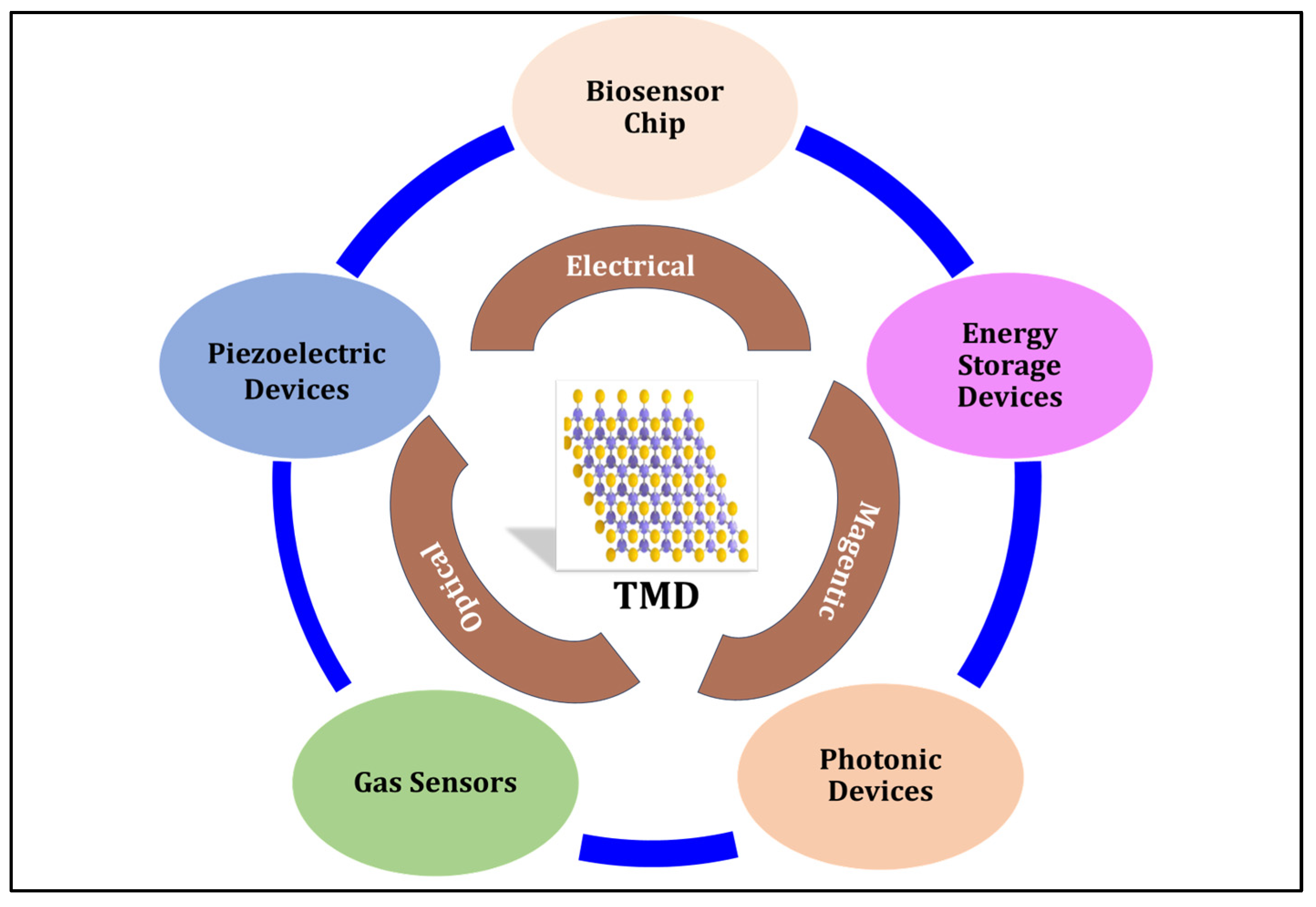
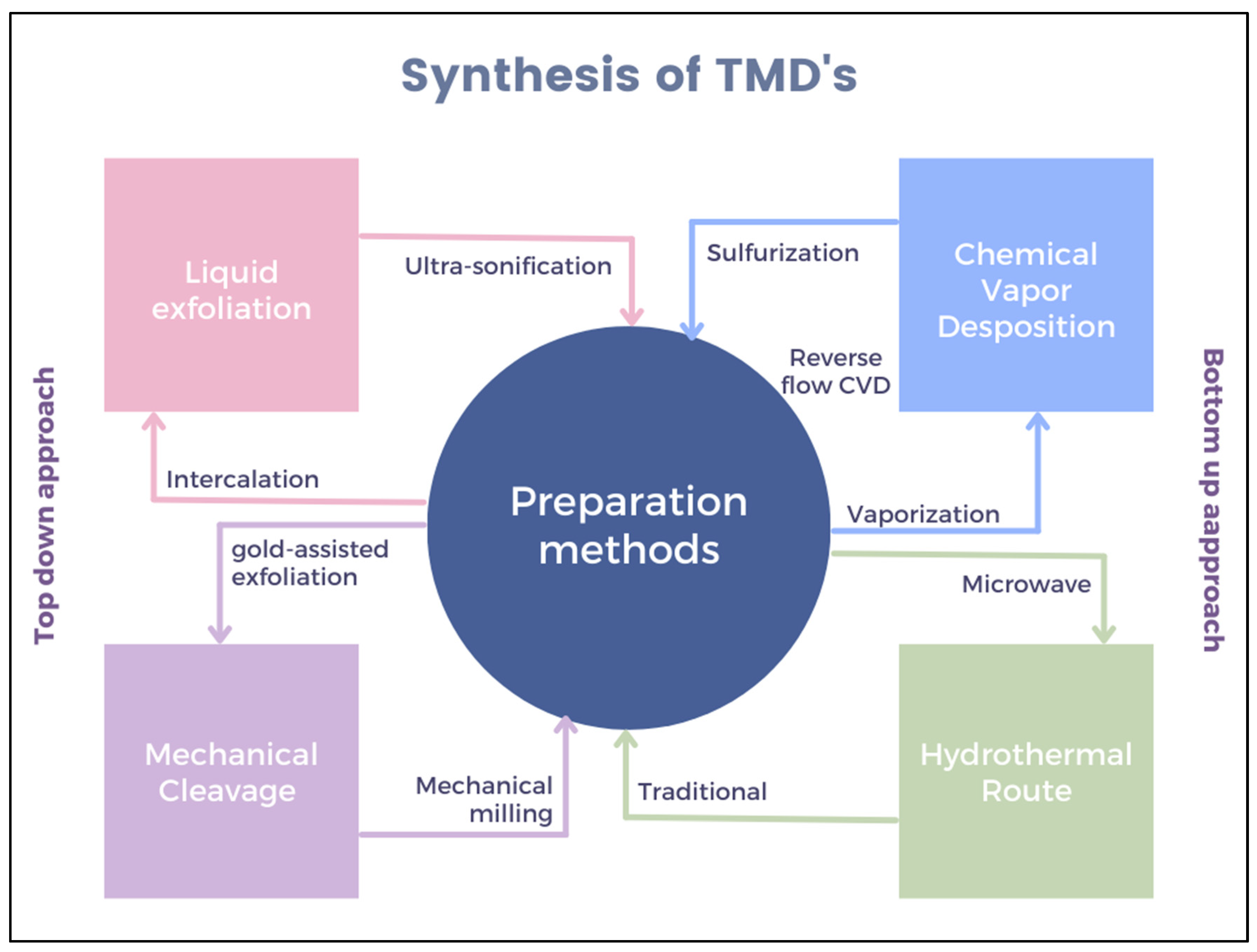
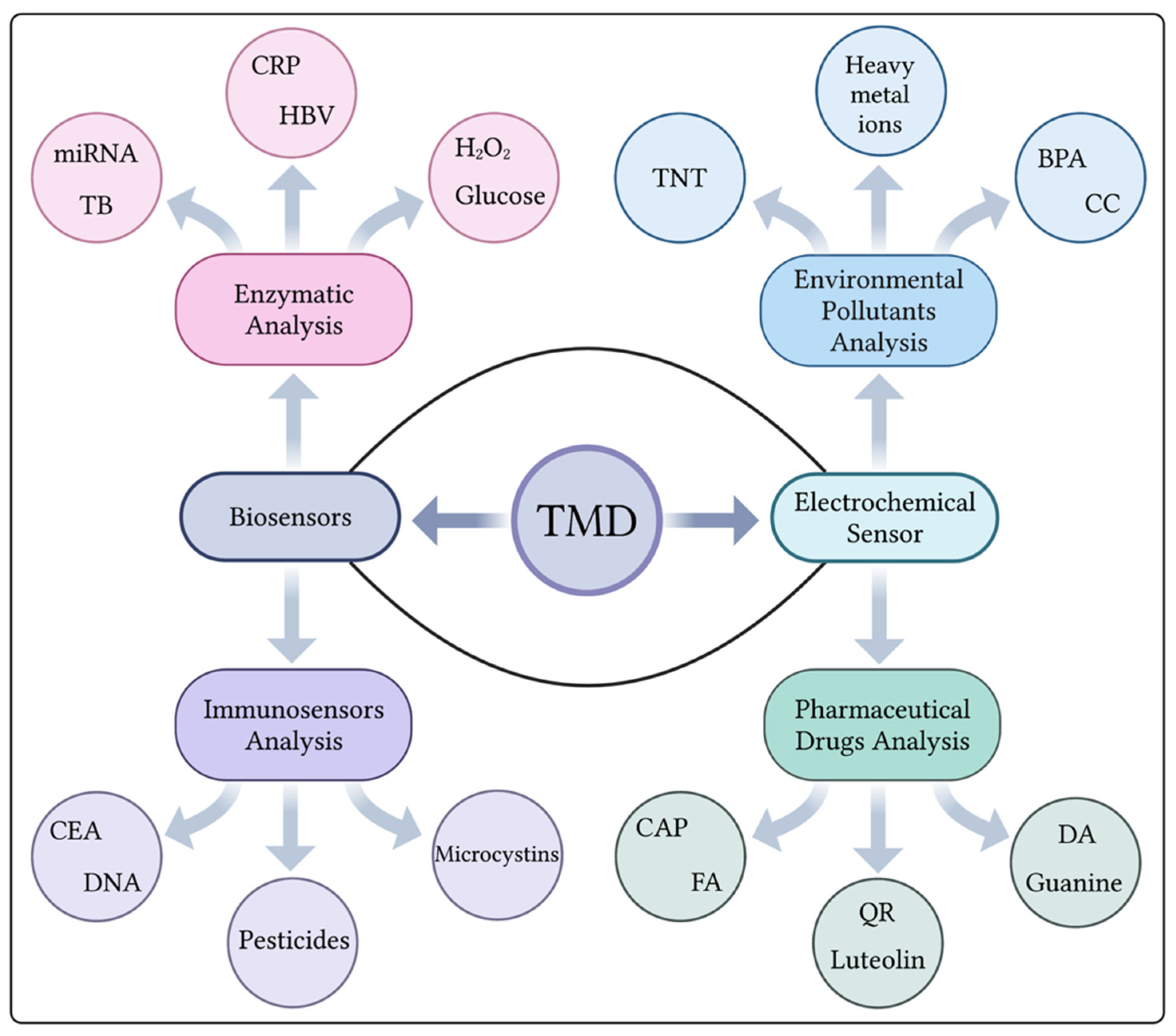
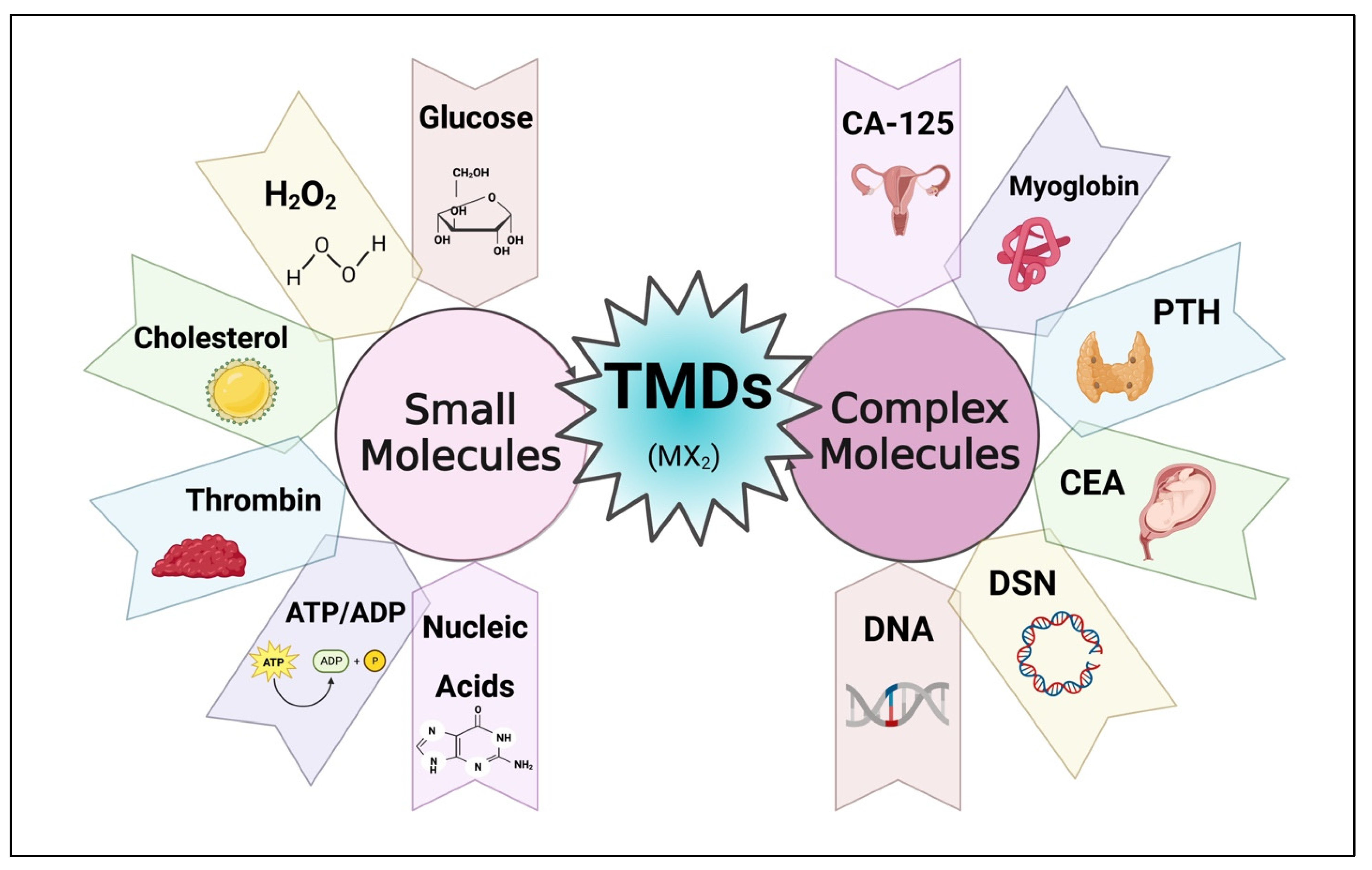

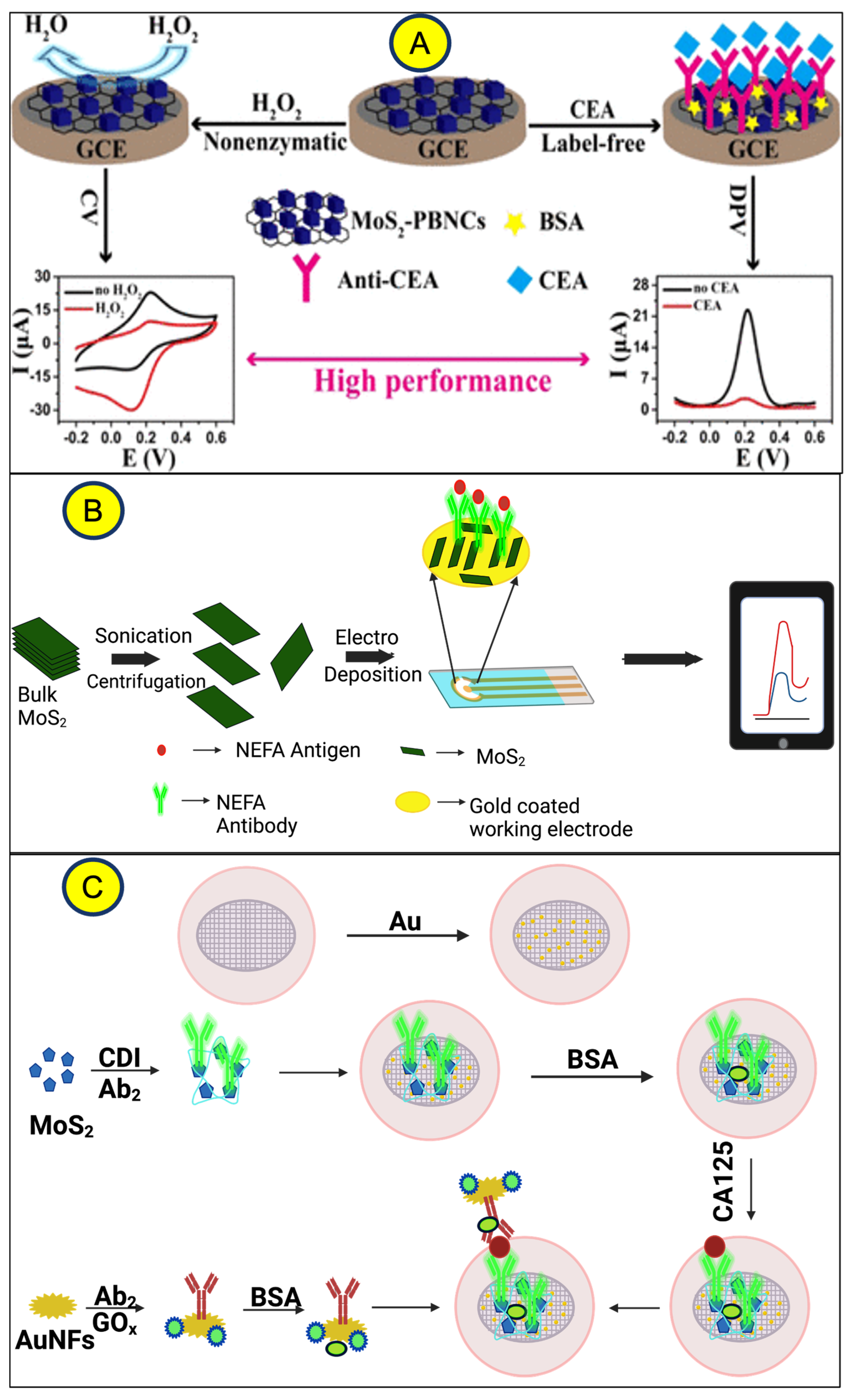
| Material | Detection Method | Target Biomolecule | Buffer/Biofluid | Detection Range | Reference |
|---|---|---|---|---|---|
| WS2/Graphite | CV | Adenine/Guanine | PBS | 0.5–20 µM | [61] |
| MoS2, TaS2, and TiS2 | FL | DNA | PBS | 0–20 nM | [62] |
| N-TiO2 | CV | DA | serum | 0.003–300 μM and 1 nM | [63] |
| CeO2 | CV | CRP | serum | 0.3 to 7.0 mg L−1 | [64] |
| WS2–Gr | CV | DNA | serum | 0.01 to 500 pM | [65] |
| WSe2 | voltammetric | stx1 and stx2 | urine, serum, milk | 50 pg mL−1 to 100 ng mL−1 | [66] |
| MoSe2/MoS2 | DPV and CV | miRNA-155 | blood | 1 fM to 1 nM | [67] |
| AuNPs-TiS2 | CV | uricase | serum | 5–2000 µM | [68] |
| VS2 | DPV | ssDNA | PBS | of 5.0 × 10−13–5.0 × 10−10 M | [69] |
| WeS2 | PEC | alpha-synuclein | serum | 10 aM to 1 nM | [70] |
| MoS2-graphene (MG) | CV | PTH | serum | 1.0 and 50.0 pg/mL | [3] |
| VS2 | DPV | 17β-estradiol | urine | 6 × 10−14 M and 5 × 10−13 to 5 × 10−9 M | [71] |
| WS2 | CV, DVP, EIS | prothrombin | serum | 100 fg mL−1 to 100 ng mL−1 | [72] |
Disclaimer/Publisher’s Note: The statements, opinions and data contained in all publications are solely those of the individual author(s) and contributor(s) and not of MDPI and/or the editor(s). MDPI and/or the editor(s) disclaim responsibility for any injury to people or property resulting from any ideas, methods, instructions or products referred to in the content. |
© 2023 by the authors. Licensee MDPI, Basel, Switzerland. This article is an open access article distributed under the terms and conditions of the Creative Commons Attribution (CC BY) license (https://creativecommons.org/licenses/by/4.0/).
Share and Cite
Madhurantakam, S.; Mathew, G.; David, B.E.; Naqvi, A.; Prasad, S. Recent Progress in Transition Metal Dichalcogenides for Electrochemical Biomolecular Detection. Micromachines 2023, 14, 2139. https://doi.org/10.3390/mi14122139
Madhurantakam S, Mathew G, David BE, Naqvi A, Prasad S. Recent Progress in Transition Metal Dichalcogenides for Electrochemical Biomolecular Detection. Micromachines. 2023; 14(12):2139. https://doi.org/10.3390/mi14122139
Chicago/Turabian StyleMadhurantakam, Sasya, Georgeena Mathew, Bianca Elizabeth David, Aliya Naqvi, and Shalini Prasad. 2023. "Recent Progress in Transition Metal Dichalcogenides for Electrochemical Biomolecular Detection" Micromachines 14, no. 12: 2139. https://doi.org/10.3390/mi14122139
APA StyleMadhurantakam, S., Mathew, G., David, B. E., Naqvi, A., & Prasad, S. (2023). Recent Progress in Transition Metal Dichalcogenides for Electrochemical Biomolecular Detection. Micromachines, 14(12), 2139. https://doi.org/10.3390/mi14122139






